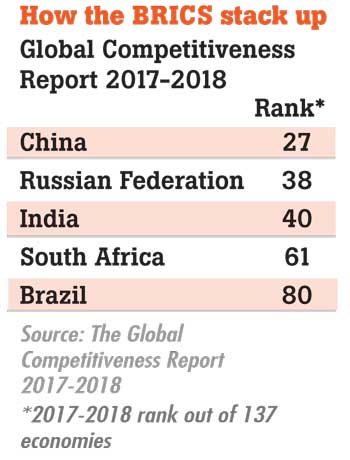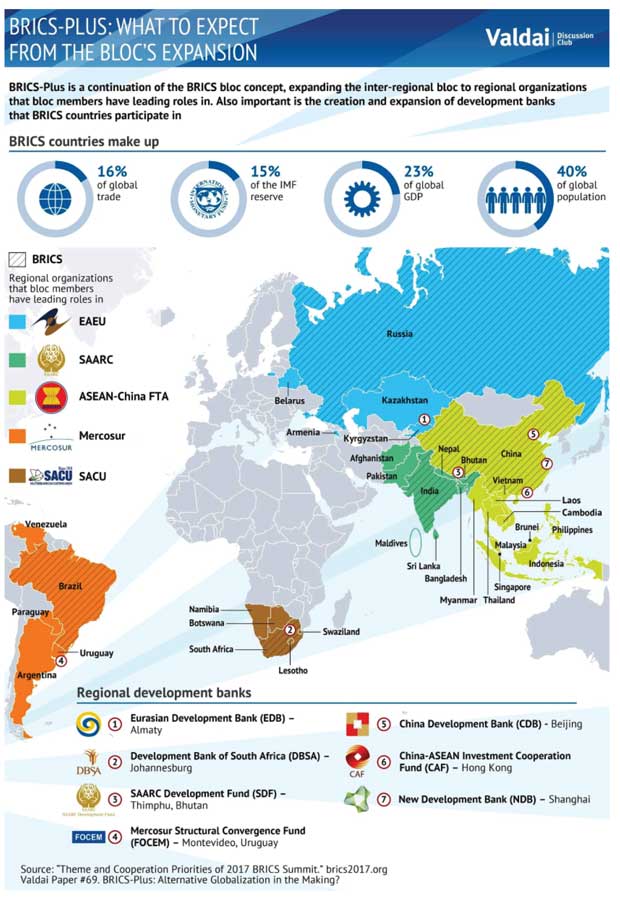14 Feb 2018 - {{hitsCtrl.values.hits}}
 Against the backdrop of waning integration impulses in the developed world, the largest developing economies are forging ahead with new initiatives directed at revitalizing regional integration.
Against the backdrop of waning integration impulses in the developed world, the largest developing economies are forging ahead with new initiatives directed at revitalizing regional integration.
China in particular is building new development institutions (Asian Infrastructure Investment Bank – AIIB), mega-regional projects (One Belt One Road), as well as new economic alliances across the globe.
Nonetheless, in the past several years, even as the activism of BRICS countries in building economic alliances across the globe has increased, the development of the BRICS formation itself has lacked vigour, argues Yaroslav Lisovolik in his paper, ‘BRICS-plus: Alternative globalization in the making?’
Indeed, despite the creation of the New Development Bank and some of the initiatives to boost economic ties between the BRICS members, there is a sense that the BRICS is starting to encounter limitations to further integration.
New gateways
One of the ways to overcome this may be to shift the focus from trade liberalization or large-scale integration towards building a wider framework of integration and cooperation in the developing world that opens new gateways for cooperation among BRICS and their partners across continents.
This kind of framework may be realized through China’s initiative to create a BRICS+ circle that according to China’s Foreign Minister Wang Yi will represent a new platform for the South-South cooperation via holding dialogues with other major developing countries or groups of developing countries to establish a more extensive partnership.
The new BRICS+ initiative is coming not just at the right time as the BRICS is seeking to find new gateways to development but it will also perhaps be one of the first truly global undertakings of the developing world in shaping a new, more balanced economic order. This in turn is made possible due to the unique nature of the BRICS, which is represented by one or several major powers in virtually every continent of the developing world.
BRICS+ circle
The first thing to realize about the uniqueness of the BRICS is that each member is also a leading economy in its continent or sub-region within a regional integration arrangement. All countries that are partners of the BRICS in these regional integration arrangements may form what might be termed as the ‘BRICS+ circle’ that becomes open to flexible and multiple modes of cooperation (not exclusively via trade liberalization) on a bilateral or regional basis.
Thus, rather than expanding the core set of BRICS members, the BRICS+ initiative seeks to create a new platform for forging regional and bilateral alliances across continents and aims at bringing together the regional integration blocks, in which BRICS economies play a leading role.
Accordingly, the main regional integration blocks that could form the BRICS+ platform include Mercosur, South African Customs Union (SACU), EEU, SAARC, as well as the China-ASEAN FTA. Altogether, in such a setting, 35 countries form the BRICS+ circle.
 The main modalities of cooperation between BRICS+ countries could involve the following:
The main modalities of cooperation between BRICS+ countries could involve the following:
A platform for trade and investment integration. The BRICS+ network could encourage expanding the set of FTAs/PTAs across individual countries or regional blocks of the BRICS+ grouping. Trade alliances do not have to follow the standard path of comprehensive FTAs but could also involve targeted/limited liberalization via preferential agreements (PTAs).
Cooperation in international organisations, including the Bretton Woods institutions, to increase the consolidated voting share. In the International Monetary Fund (IMF), the consolidated share of the BRICS is just below the 15 percent mark. The addition of BRICS+ partners would raise the consolidated share of the vote by 1-2 percentage points, depending on the exact composition of the BRICS+ circle. This would enable the BRICS+ to have a blocking stake with respect to the key decisions of the IMF. BRICS+ countries could also form alliances in other international organisations, including the WTO, where a BRICS+ group in negotiations could complement other South-South alliances.
Cooperation between development banks and other development institutions formed by BRICS+ economies, namely the Eurasian Development Bank (EDB), Development Bank of South Africa (DBSA), SAARC Development Fund (SDF), Mercosur Structural Convergence Fund (FOCEM), China Development Bank (CDB), China-ASEAN Investment Cooperation Fund (CAF), and New Development Bank (NDB). Within this group of development institutions, the NDB could potentially perform a coordinating role with respect to BRICS+ initiatives, while there could also be a role for the AIIB, which could serve as a platform for bringing together the financing from developing and developed economies.
Use of national currencies/payment systems: The BRICS+ circle could serve as an extensive platform for the creation of BRICS+ countries’ payment systems and expansion in their use. It could also serve as a platform for extending the use of national currencies in mutual trade and investment transactions, thus reducing dependency on the US dollar and euro.
Cooperation in establishing own reserve currencies/regional and global financial centres. The countries that form part of the regional blocks of BRICS+ could support each other’s efforts in promoting the creation of international financial centres by listing companies in the exchanges of BRICS+ economies. There may also be greater cooperation in advancing some of the BRICS+ currencies as reserve currencies that become part of gold and currency reserves of the respective Central Banks.
Taking BRICS+ a step further: the BRICS++ circle
The operation of the BRICS+ framework need not limited to the regional blocks of the BRICS core. Indeed, each of the regional integration groups led by BRICS economies also has its own network of economic alliances with third countries.
The formation of such alliances expands the wider BRICS ‘circle of friends’ to what may be termed as BRICS++, which complements the possible alliances within the BRICS+ circle with an opportunity to form a set of alliances with the rest of the developing countries. In effect, the BRICS+ model is akin to the competitive liberalization policy in the developed world, in which regionalism is complemented and reinforced by bilateral alliances.
What about the rest of the world that is not immediately part of the BRICS+ and BRICS++ frameworks?
Firstly, there is a need for a framework of cooperation between the BRICS+ circle and the developed world, which can be based on the existing FTAs or comprehensive economic agreements with developed countries formed by the BRICS+ economies.
The investment liberalization with the countries of the developed world may be pursued in the context of such joint projects as well as within the World Trade Organisation (WTO) and other global organisations where the BRICS+ economies could form a unified group.
In the framework outlined above, the essence of the BRICS+ initiative is not the enlargement of the BRICS core to include the largest developing countries but rather to create a network of alliances that would be comprehensive and representative of all major regions/continents across the developing world.
In this respect, the BRICS+ paradigm is more about inclusiveness and diversity rather than about selecting the largest heavyweights.
By its very nature of being present in all of the key regions and continents of the developing world, the BRICS could perform the unique role of a comprehensive platform for economic cooperation across the globe.
Thus, the BRICS+ concept is first and foremost about a different approach to economic integration and a different way to structure alliances globally.
The key question to ask today is: ‘What kind of integration and globalization framework do we need for sustainable development?’ The answer is to move away from the core-periphery model of globalization that is characterized by extreme global imbalances and high inequality towards a decentralized “no core – no periphery” framework of BRICS+.
The BRICS+ framework also needs to recognize that globalization will be inherently incomplete and thus should seek to emphasize the opportunity for varying standards and modes of integration as opposed to the proselytizing approach of enforcing universal standards that is fraught with disruptions and reversals. Most importantly, the nature of trade integration pursued by the BRICS and its institutions could be rendered more inclusive (open to participation for other developing and developed economies) as opposed to the exclusive nature of integration largely pursued in the past that was based on narrow geographical or ‘commonality of values’ criteria. The emergence of BRICS offers the world economy a unique opportunity to reload the international integration process and to make it truly global, non-discriminatory and more compliant with the global rules of the WTO.
(Yaroslav Lissovolik is Programme Director of Valdai Discussion Club)

10 Jan 2025 1 hours ago
10 Jan 2025 1 hours ago
10 Jan 2025 2 hours ago
10 Jan 2025 3 hours ago
10 Jan 2025 3 hours ago